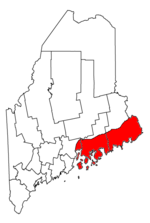Down East
"Down East"or"Downeast"is a term for parts of eastern coastalNew EnglandandCanada,particularly theU.S. stateofMaineand Canada'sMaritime Provinces,an area that closely corresponds to the historical French territory ofAcadia.The phrase apparently derives from sailing terminology: sailors from western ports saileddownwindtoward the east to reach the area.
A person from this area may be called a "down-easter." Within Maine, the phrase "down east" may refer specifically to the state's easternmost regions, also calledDown East Maine.
TheDowneast Maine National Heritage Areawas established in the National Heritage Area Act in 2022.[1]TheNational Heritage Areawill help preserve more historic and cultural sites inHancockandWashingtoncounties.[2][3]
Etymology
[edit]The origin of the phrase "Down East" is typically traced to nautical terminology referring to direction, rather than location. In the warm months most suitable for sailing, theprevailing windsalong the coast of New England and Canada blow from the southwest, meaning ships saildownwindto go east. As such, the northeastern stretches were said to be "Down East" in relation to major western cities such asBoston.[4][5]Correspondingly, sailors spoke of going "up to Boston" from Down East ports, a phrase still common in Maine, despite the fact that Boston is around fifty miles to the south of Maine.[6]The term can be used as an adverb, adjective, or noun. TheOxford English Dictionarytraces the earliest known use in print to 1825. The phrase "down-easter", meaning a person from "Down East", appeared in print in 1828.[7]
Uses
[edit]
The phrase "Down East" is used in several ways. Most broadly, it refers to areas from northeasternNew EnglandintoCanada'sMaritime Provinces.[4][7][8][9][10]Sargent F. Collier wrote that Down East extended fromMaineinto Canada as far asChaleur Bay.This area is similar to the boundaries of the historical French colony ofAcadia;Collier regarded this as a cultural legacy of the former colony.[10]According to Maine authorJohn Gould,Down East is "a never-never land always east of where you are". The term is relational, withBostonbeing the traditional referent for determining what is "Down East". As such, sailors going from one port in Maine to another nearby may have said they were going "down Maine" or "east'ard", reserving "Down East" for farther points.[11]
WithinNew England,"Down East" often refers specifically toMaine,especially the coastal areas.[12][13]The phrase has widespread use in the state; Maine's largest monthly magazine is titledDown East.[14]Amtraknamed its passenger train service between Boston andBrunswick, MainetheDowneaster.[15]The term "Down East" provided the name for a prominent type ofsailing shipdeveloped in Maine in the later 19th century, theDown Easter.Down Easters were a modification of the earlierclipper,with new lines and rigging enabling it to carry substantially more cargo. Primarily used to transport wheat and other goods fromCaliforniato European markets, Down Easters were characteristically built in Maine, and their captains often came from the state. A significant part of Maine's maritime legacy, they were among the last prominent sailing ships built beforesteamshipscame to dominate the industry.[16]While steamships may have supplanted sailing ships in some contexts, this prominence just before the decline led Maine boatbuilders to remain in demand for sailing yachts and motor yachts; a common modern design influenced by coastal Maine's ubiquitous lobster boats is made by several manufacturers under names resembling 'downeaster'.[citation needed]
In Maine, "Down East" may refer more narrowly to the easternmost section of the state along theCanada–US border.This area, also known as "Down East Maine" or "Downeast Maine", lies on the coast roughly between thePenobscot Riverand the border, including ruralHancockandWashingtoncounties and the towns ofDeer Isle,Bar Harbor,Machias,Jonesport,andEastport.[5][12]This was among the last parts of the state settled by Europeans. Due to its thankless climate it saw little settlement by the French, and British colonists arrived only after French control ended in 1763. Initially attracted by the availability of land for farming, the early British settlers soon turned to fishing to survive; fishing remains a significant economic driver. Largely due to its inhospitable climate and remoteness, Down East Maine remained one of the state's least developed areas throughout the 20th century.[5]In more recent years, Down East Maine and the Greater Portland area have emerged as an important center for thecreative economy,[17]which is also bringinggentrification.[18]
In Canada, "Down East" typically refers to theMaritime Provinces:New Brunswick,Nova Scotia,andPrince Edward Island.[4][9]Newfoundlandand theGaspé PeninsulaofQuebecare sometimes included.[10]The term gave its name toDown East fiddling,which developed in the Maritimes and has become one of the most prominent styles ofCanadian fiddling.The style is closely associated with New Brunswick nativeDon Messer,who hosted a radio show on Prince Edward Island beginning in 1939 and had a wide influence over fiddle music in Canada. The Down East style is distinguished by simple playing and dance-ready rhythms.[19]
References
[edit]- ^"National Heritage Area Act".Congress.gov.December 22, 2022.
- ^"Bill in Congress would create Downeast Maine National Heritage Area".MaineBiz.April 5, 2022.
- ^"King, Golden Led Downeast National Heritage Area Legislation Passes Congress, Heads to President's Desk".U.S. Representative Chellie Pingree.December 23, 2022.RetrievedDecember 25,2022.
- ^abc"Down East".Oxford Dictionaries.Oxford University Press. 2016. Archived fromthe originalon July 21, 2015.RetrievedJanuary 5,2015.
- ^abcWoodard, Colin (2004).The Lobster Coast: Rebels, Rusticators, and the Struggle for a Forgotten Frontier.New York: Viking Press. p.32.ISBN0143035347.
- ^"Frequently Asked Questions".Down East.Archived fromthe originalon October 21, 2001.
- ^ab"Down east".OED Online.Oxford University Press. December 2015.RetrievedJanuary 5,2015.
- ^"Down East".Dictionary.com.2016.RetrievedJanuary 5,2015.
- ^ab"Down east".Merriam-Webster.Merriam-Webster. 2015.RetrievedJanuary 5,2015.
- ^abcCollier, Sargent F. (1953).Down East: Maine, Prince Edward Island, Nova Scotia, and the Gaspé.Houghton Mifflin. p. i.
- ^Gould, John(2015).Maine Lingo: A Wicked-Good Guide to Yankee Vernacular.Down East Books.pp. 78–79.ISBN978-1608935673.
- ^abVan Riper, Frank (1991).Down East Maine.Down East Books.pp. 5–6.ISBN089272448X.
- ^Gould, John(2015).Maine Lingo: A Wicked-Good Guide to Yankee Vernacular.Down East Books.p. 78.ISBN978-1608935673.
- ^"Our Company".downeast.com.Down East.2016.RetrievedJanuary 13,2015.
- ^"What's in a Name? How Amtrak Trains Got Their Names"(PDF).Amtrak.2011.RetrievedSeptember 4,2016.
- ^Gould, John(2015).Maine Lingo: A Wicked-Good Guide to Yankee Vernacular.Down East Books.p. 79.ISBN978-1608935673.
- ^Maine's Creative Economy.Accessed October 5, 2021.
- ^"Welcome to Portlyn".downeast.com.January 16, 2017.RetrievedOctober 6,2021.
- ^Whitcomb, Ed (2010).Canadian Fiddle Music.Mel Bay Publications. pp. 10–11, 13–14.ISBN978-1609742133.
